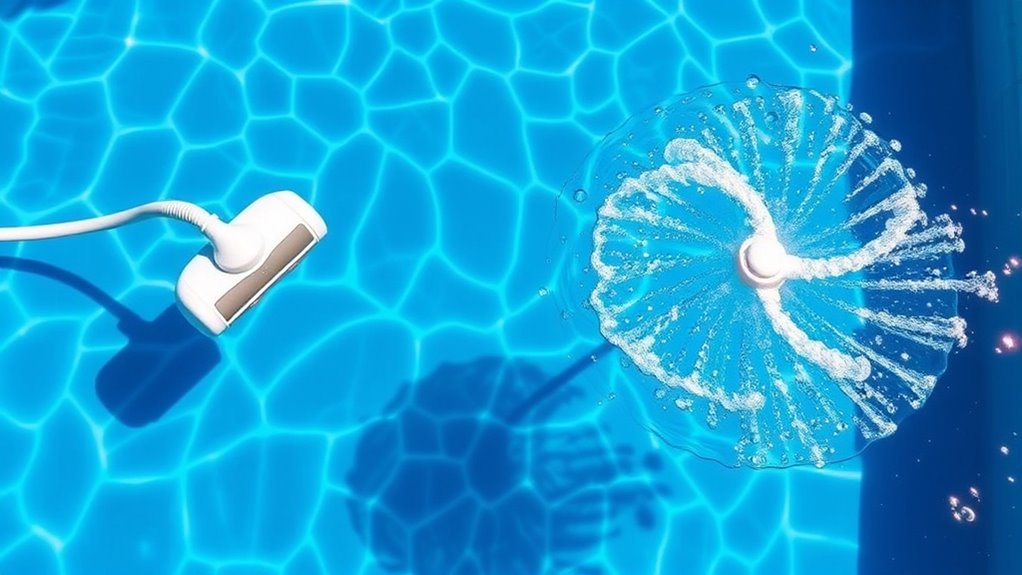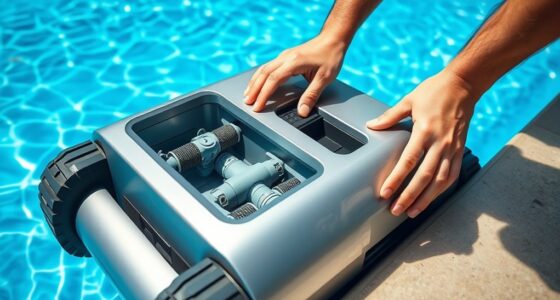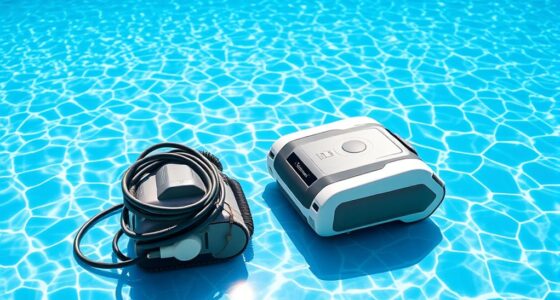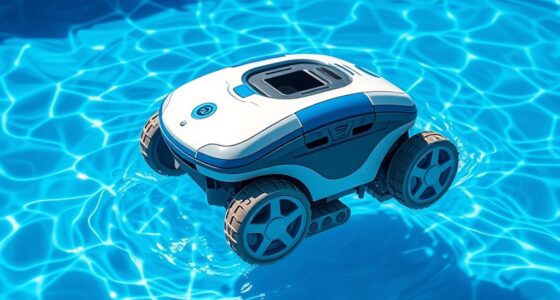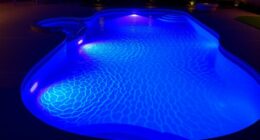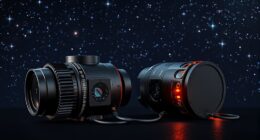Suction and pressure pool cleaners operate differently: suction cleaners attach to your pool’s filtration system and use vacuum power to pick up debris, making them affordable and easy to install. Pressure cleaners rely on high-pressure jets powered by a dedicated pump, covering large or irregular-shaped pools efficiently. Choosing the right depends on your pool size, shape, and debris type. Stick around to discover more about how each cleaner suits your needs best.
Key Takeaways
- Suction cleaners attach to the pool’s filtration system, while pressure cleaners use dedicated pumps for movement.
- Suction cleaners are more energy-efficient and affordable, suitable for small to medium pools.
- Pressure cleaners handle larger debris and cover bigger or irregular-shaped pools more effectively.
- Suction cleaners have simpler maintenance with fewer moving parts; pressure cleaners may need more upkeep.
- Surface compatibility varies; suction cleaners excel on smooth surfaces, pressure cleaners work well on larger debris and complex shapes.
How Suction Pool Cleaners Work

Suction pool cleaners operate by attaching to your pool’s filtration system, creating a powerful vacuum that lifts debris from the pool surface and floor. As they work, they rely on proper pool water circulation to move debris toward their intake. Efficient circulation ensures the cleaner can reach all areas, preventing debris buildup. These cleaners typically use less energy because they don’t require an additional pump, making them more cost-effective over time. Since they depend on the existing filtration system, their energy consumption remains relatively low, especially if your pool’s pump is energy-efficient. Regular maintenance of your pool’s circulation system helps maximize cleaning performance and keeps energy use minimal. Additionally, understanding contrast ratio can help in selecting projectors that display clearer images, which is useful if you use a projector to monitor pool areas. Proper selection of cleaner types ensures optimal performance and longevity. Incorporating smart technology can further enhance the efficiency of your pool cleaning setup by providing real-time monitoring and control. To ensure consistent cleaning results, it’s also important to consider filter maintenance to prevent clogging and maintain optimal water flow.
How Pressure Pool Cleaners Operate
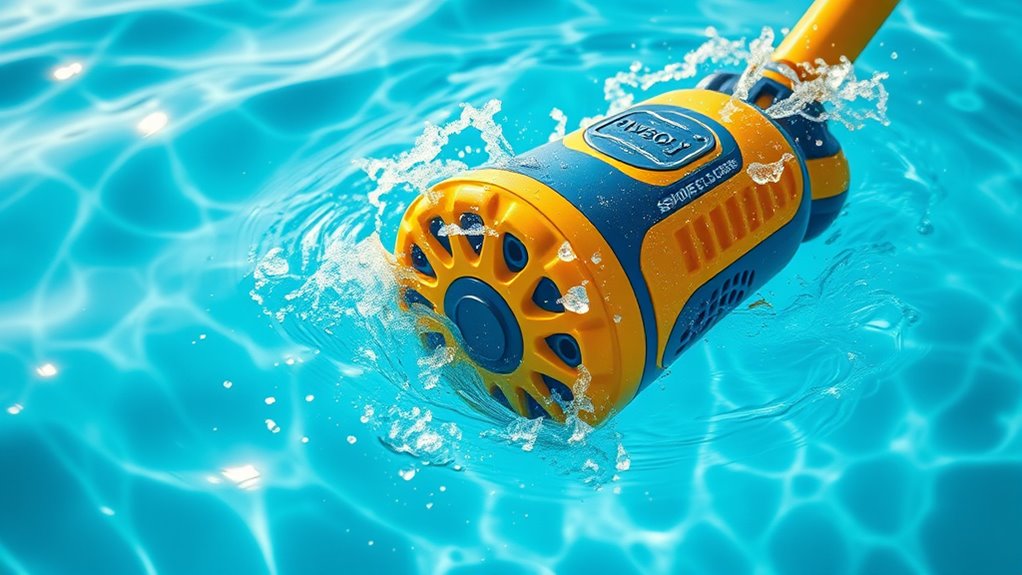
Pressure pool cleaners operate by using dedicated pumps to generate high-pressure jets that propel the cleaner across the pool floor and walls. These jets push the cleaner as it moves, allowing it to cover large areas efficiently. The cleaner’s movement depends on the pool size; bigger pools require more powerful pumps to maintain effective coverage. Because they rely on high-pressure jets, these cleaners tend to be more energy-efficient than suction models, especially in larger pools. They use less electricity overall, making them a cost-effective choice for regular cleaning. Additionally, their design lets them navigate complex pool shapes and obstacles more easily. Understanding pool types can help determine the most suitable cleaning method. Furthermore, the design of pressure cleaners often includes adjustable jets, providing better control over cleaning coverage. The maintenance requirements of pressure pool cleaners are generally straightforward, contributing to their popularity among pool owners. Overall, pressure pool cleaners offer a reliable, energy-efficient way to keep your pool clean, especially if you have a sizable or intricate pool layout.
Installation and Setup Processes
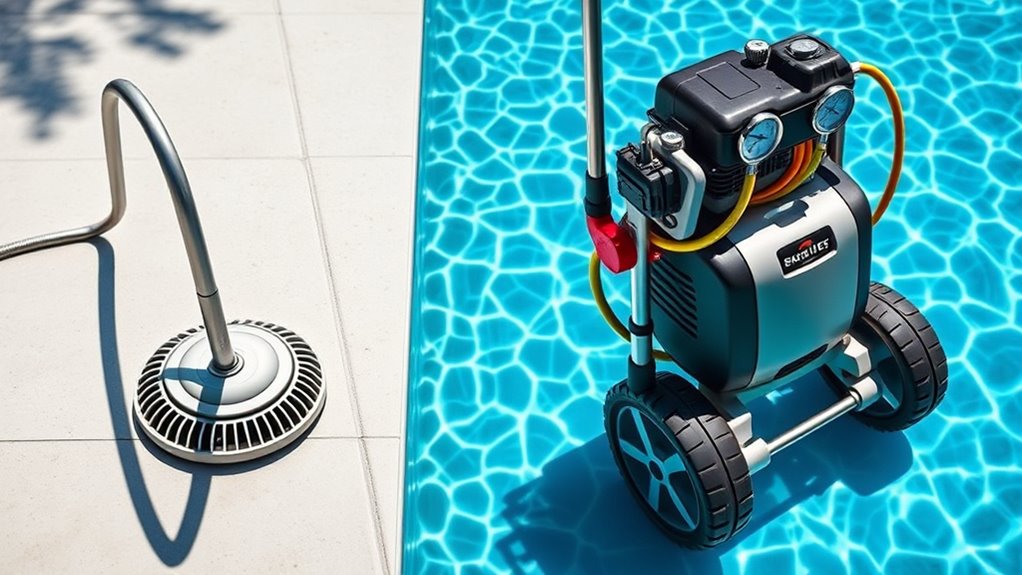
Setting up a pressure pool cleaner is straightforward, but it requires careful attention to guarantee peak performance. First, connect the hose to the cleaner and ensure the filter is clean; replacing the filter when needed helps maintain ideal suction. Next, attach the hose to the dedicated pressure port on your pool’s return jet or skimmer, depending on your model. Verify that your power source requirements are met—most pressure cleaners need a compatible pump with sufficient flow rate. Once connected, turn on the pump and observe the cleaner’s movement to ensure proper operation. Regular filter replacement is essential to keep the cleaner functioning efficiently. Additionally, understanding the importance of proper equipment setup can help you optimize your pool cleaning process and prolong the lifespan of your cleaner. Ensuring the correct pressure levels are maintained is also vital for optimal cleaning performance. Following these steps ensures your pressure pool cleaner is correctly installed and ready to keep your pool pristine.
Cleaning Performance and Effectiveness

When it comes to cleaning performance, you’ll want to examine how well each type of cleaner removes dirt and debris from your pool. You’ll also need to look at how evenly they cover the surface and handle different sizes of debris. Understanding these factors helps you choose the cleaner that keeps your pool spotless and well-maintained. Additionally, considering the industrial juice manufacturing process can offer insights into the efficiency of cleaning mechanisms, as both rely on optimized processes for consistent results. For example, pressure pool cleaners often leverage a different cleaning mechanism compared to suction models, which can impact overall effectiveness. The design and mechanical operation of each cleaner influence their ability to adapt to various pool shapes and debris types, ensuring comprehensive cleaning results. Furthermore, the technology involved in each system plays a crucial role in their capacity to maintain high cleaning standards over time.
Dirt Removal Efficiency
Dirt removal efficiency is a key factor in determining how well a pool cleaner performs its job, and both suction and pressure models have their strengths. Suction cleaners excel at picking up fine debris like dirt and sand because of their strong vacuum power and effective filter types. Effective filtration is crucial to trap small particles and maintain water clarity. Pressure cleaners, on the other hand, are better at dislodging larger debris such as leaves and twigs, thanks to their forceful jets. When considering dirt removal, think about your pool’s typical debris and the filter types used in your cleaner, as they influence cleaning performance. Additionally, energy consumption plays a role; some models operate more efficiently than others, impacting ongoing costs. Regular maintenance of the filter system can also enhance dirt removal efficiency and overall cleaning effectiveness. A properly maintained filter ensures consistent suction power and prolongs the lifespan of your cleaner. Moreover, understanding the technology behind these cleaners can help you choose the most suitable option for your needs. Ultimately, choosing the right cleaner depends on your specific cleaning needs and the type of debris you encounter.
Surface Coverage Consistency
Surface coverage consistency is essential for ensuring thorough cleaning across your pool’s entire surface. When evaluating suction and pressure cleaners, consider how well they maintain coverage uniformity. A cleaner with good coverage will reach every part of your pool surface without missing spots. Additionally, the movement patterns of the cleaner can be optimized by adjusting its settings or pattern to improve coverage. Headphones compatibility can influence how well the cleaner navigates different pool surfaces and obstacles. To assess this, look for: 1. Consistent movement patterns that cover the entire pool surface evenly. 2. The ability to navigate corners and tight spaces without skipping areas. 3. Minimal missed spots or uneven cleaning patches during operation. Properly designed movement algorithms are crucial for ensuring comprehensive coverage. A cleaner with strong surface coverage ensures dirt and debris are removed uniformly, reducing the need for manual touch-ups. Moreover, surface type compatibility plays a key role in achieving optimal coverage across various pool surfaces. Additionally, understanding the tuning capabilities of the cleaner can help customize its operation for different pool conditions. Recognizing how surface type influences cleaner performance can further enhance cleaning efficiency. Ultimately, coverage uniformity impacts both the efficiency and overall effectiveness of your pool cleaning routine.
Debris Handling Capacity
How well a pool cleaner handles debris directly impacts its overall cleaning performance and effectiveness. A cleaner with a high debris capacity can pick up larger or more numerous debris without frequent stops or clogs. For suction cleaners, filter capacity is vital; a larger filter allows for longer cleaning sessions before needing to be emptied. Pressure cleaners typically have a dedicated debris bag or trap, which, if sizable, enhances debris handling. If your cleaner’s debris capacity is limited, it may leave debris behind or require frequent maintenance, reducing efficiency. Choosing a model with sufficient filter capacity and debris capacity ensures thorough cleaning, less downtime, and better overall results. In short, debris handling capacity is key to maintaining a clean, debris-free pool with less effort. Additionally, selecting a cleaner with effective debris management features can significantly improve cleaning efficiency and reduce maintenance needs.
Maneuverability and Coverage Area
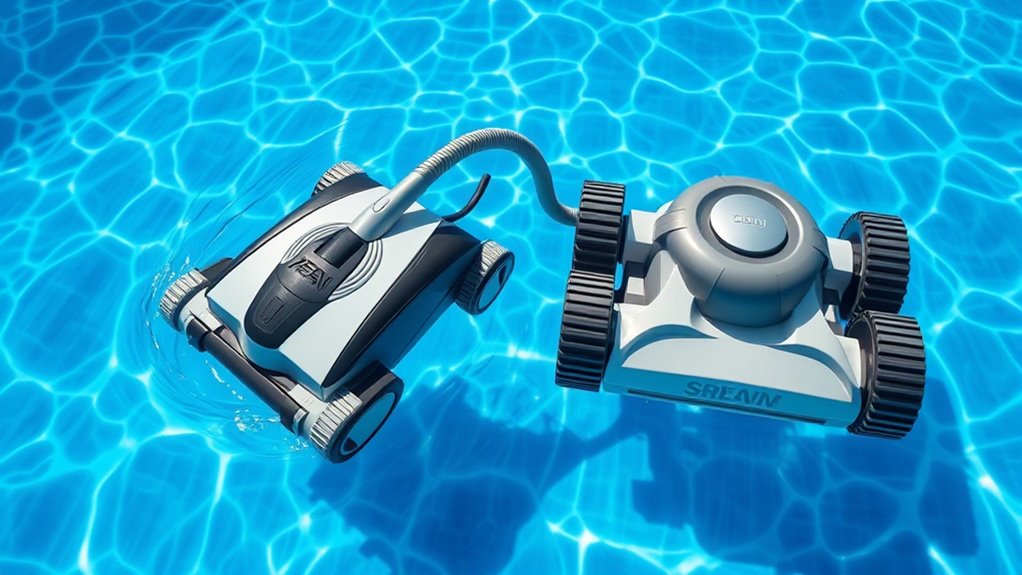
Your pool cleaner’s ability to navigate smoothly impacts how thoroughly it covers the entire surface. With precise navigation, it can reach all corners without missing spots. Considering its range of coverage helps you decide which type suits your pool best.
Navigational Precision
Navigational precision plays a vital role in how effectively a pool cleaner covers the entire area. High navigation accuracy ensures the cleaner moves systematically, reducing missed spots. Obstacle avoidance is essential, preventing the device from getting stuck or damaging itself. To maximize efficiency, focus on these key features:
- Precise movement patterns that adapt to pool shape and obstacles.
- Sensors that detect and navigate around obstacles smoothly.
- Algorithms that optimize coverage without redundancy.
Suction cleaners often excel in navigation accuracy, thanks to sensors and programmed routes. Pressure cleaners may rely more on random movement, which can affect obstacle avoidance. Your choice depends on how accurately and efficiently you want your cleaner to navigate and cover every inch of your pool.
Cleaning Coverage Range
Maneuverability and coverage area determine how thoroughly a pool cleaner can clean your entire pool. A cleaner with good maneuverability navigates the pool surface efficiently, reaching all corners and tight spots. This directly impacts the cleaning coverage, ensuring no area is missed. Suction cleaners often have limited coverage due to their narrower paths, but they excel at detailed cleaning on specific surfaces. Pressure cleaners typically offer a broader cleaning range, covering more of the pool surface faster. Your choice depends on the size and shape of your pool, as well as your cleaning needs. If you want extensive coverage and faster cleaning, a pressure cleaner might be better. For precision and detailed surface cleaning, a suction model provides more targeted coverage.
Maintenance and Durability Factors
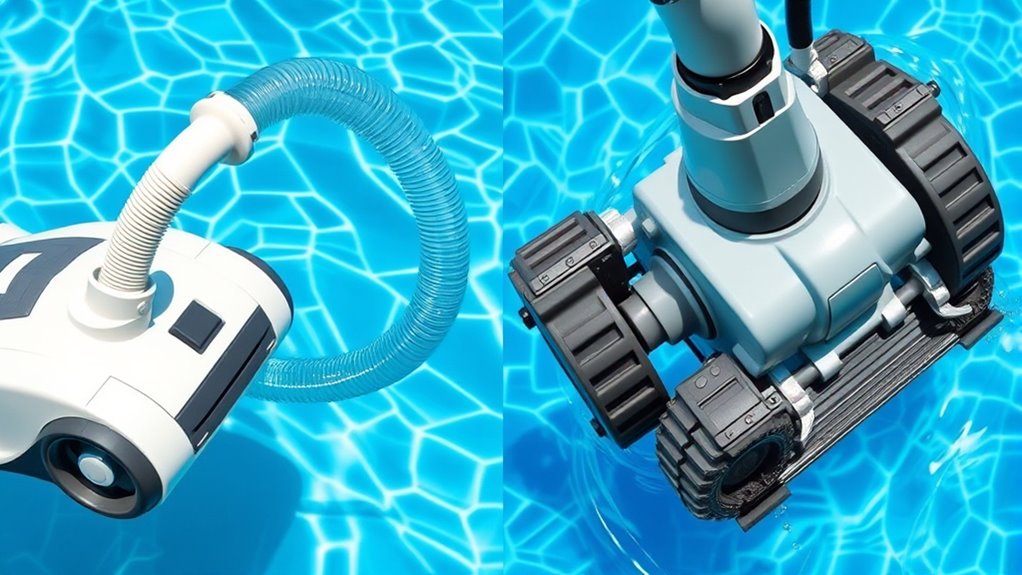
When considering maintenance and durability, suction and pressure pool cleaners each have distinct strengths and challenges. Suction cleaners generally experience less wear and tear because their simple design involves fewer moving parts, and their material quality tends to be robust. Pressure cleaners, with more complex components, may require more frequent upkeep. To keep your cleaner in top shape, focus on these factors:
- Regularly inspect for signs of wear and tear, replacing worn brushes or hoses promptly.
- Choose models made from high-quality, durable materials to withstand frequent use.
- Clean filters and internal parts regularly to prevent buildup that can accelerate damage.
Cost and Budget Considerations
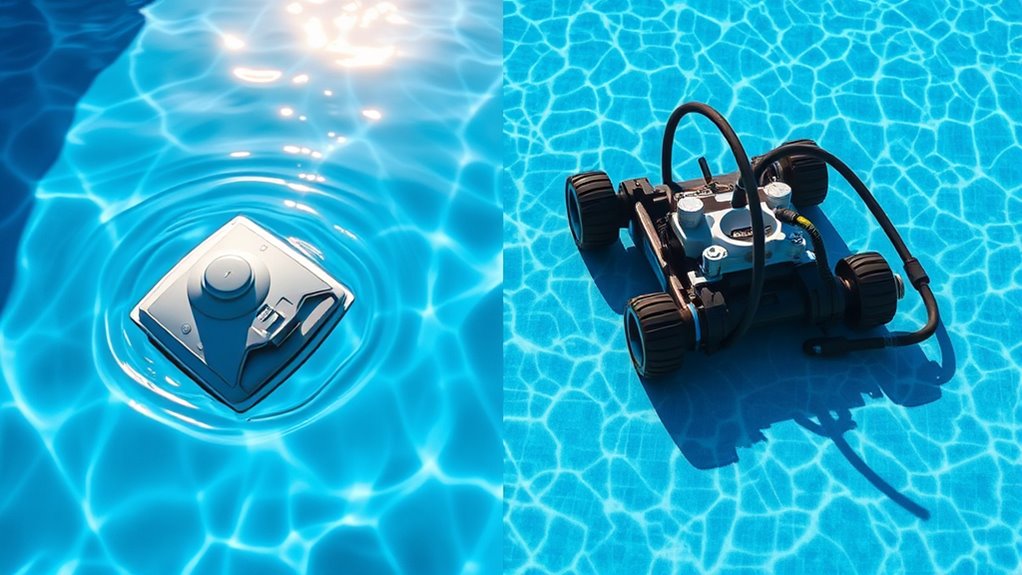
Cost and budget are important factors to contemplate when choosing between suction and pressure pool cleaners, as their prices can vary considerably. If you have strict budget constraints, suction cleaners generally offer a more affordable option upfront and in the long run. They tend to be less expensive to purchase and maintain, making them ideal if you’re looking for affordability options. Pressure cleaners, while often more costly initially, may save you money over time through better cleaning efficiency and durability. Consider your financial situation carefully and compare the costs of equipment, installation, and maintenance. Balancing your budget constraints with the benefits each type offers will help you select the most cost-effective pool cleaner suited to your needs.
Ideal Pool Types for Each Cleaner
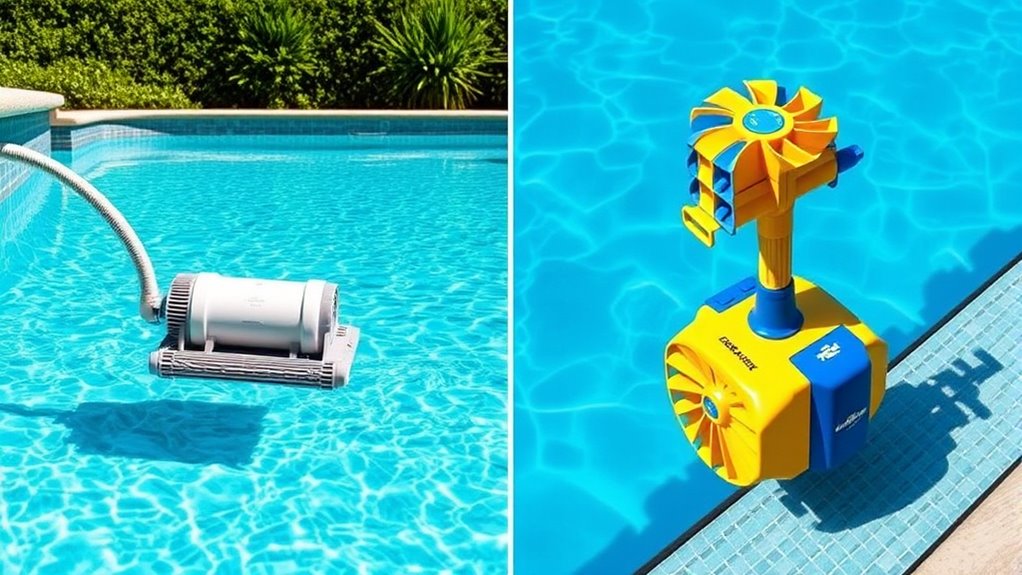
Choosing the right pool cleaner depends on the type of pool you have. For small to medium pools, suction cleaners work well because they handle limited space efficiently. If you have a large pool, pressure cleaners are more suitable since they cover bigger areas faster. Your pool shape also matters:
- Round pools—pressure cleaners excel here due to their ability to navigate open, symmetrical spaces easily.
- Rectangular pools—both types work, but suction cleaners are ideal for consistent coverage in elongated shapes.
- Irregularly shaped pools—pressure cleaners tend to adapt better to complex contours and tricky corners.
Matching your pool size and shape with the cleaner’s capabilities guarantees efficient cleaning and longer equipment lifespan.
Pros and Cons of Suction and Pressure Models
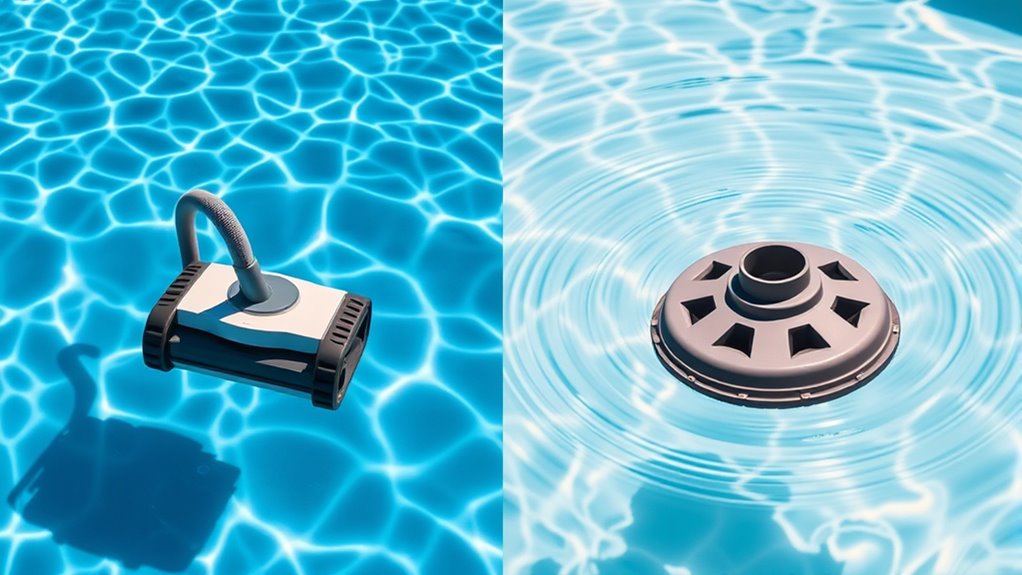
Suction and pressure pool cleaners each come with their own set of advantages and drawbacks, influencing how well they perform depending on your pool’s specific needs. Suction models excel in robotic automation, allowing you to set them and forget, while providing thorough cleaning in smaller or mid-sized pools. However, they often require manual operation for setup and maintenance. Pressure cleaners are powerful and better suited for larger pools with stubborn debris, but they tend to be more complex to install and operate. They don’t offer robotic automation, so you’ll need to be more hands-on. If you prefer minimal effort, suction cleaners are ideal, but if you want maximum power and don’t mind manual operation, pressure models could be the better choice.
Frequently Asked Questions
Which Cleaner Is More Environmentally Friendly?
When choosing a pool cleaner, you wonder which is more eco-friendly. Eco-friendly options, like robotic cleaners, typically use less energy and water, promoting water conservation. They operate efficiently without relying heavily on your pool’s pump, reducing overall energy consumption. By selecting a cleaner designed with sustainability in mind, you help conserve resources and minimize environmental impact, making your pool maintenance more eco-conscious and sustainable.
How Do Suction and Pressure Cleaners Impact Pool Water Chemistry?
You wonder how suction and pressure cleaners impact your pool water chemistry. Both cleaners can influence chemical balance and algae control by stirring debris and contaminants, which may affect pH levels and overall water quality. Regular cleaning helps maintain proper chemical balance, preventing algae buildup and ensuring safe, clear water. Be mindful of how often you clean and adjust your chemicals accordingly to keep your pool healthy and inviting.
Can Both Cleaner Types Be Used Simultaneously?
You can definitely use dual operation with suction and pressure pool cleaners simultaneously. Many pool owners find that running both cleaners at the same time improves overall cleaning efficiency, especially in larger pools with stubborn debris. Just verify your pool’s circulation system can handle the added demand, and follow the manufacturer’s instructions. This way, you maximize cleaning coverage without risking damage or compromising water quality.
What Safety Precautions Are Necessary During Installation?
Think of installation safety as planting a sturdy tree—solid ground is essential. During installation, you must follow electrical precautions carefully to prevent shocks or fire. Always disconnect power sources before wiring, use waterproof connectors, and guarantee proper grounding. Keep the area dry, wear protective gear, and read the manufacturer’s instructions thoroughly. These steps act like roots anchoring your setup, ensuring safe, reliable operation of your pool cleaner.
How Do Weather Conditions Affect Cleaner Performance?
Weather impact can substantially influence your pool cleaner’s performance, especially during seasonal changes. Heavy rain or wind may hinder its ability to operate effectively, while extreme heat can cause debris buildup or damage. Cold temperatures might slow down or freeze parts, reducing efficiency. To guarantee ideal seasonal performance, regularly inspect and clean your cleaner, and consider weather conditions when scheduling maintenance or operation.
Conclusion
Choosing between suction and pressure pool cleaners depends on your pool’s size and shape. For example, if you have a large, complex pool, a pressure cleaner might cover more ground quickly. Conversely, a small, simple pool could benefit from a suction cleaner’s efficiency. Think about your maintenance preferences and budget, then select the cleaner that fits your needs best. Whichever you choose, regular upkeep keeps your pool sparkling and inviting.
